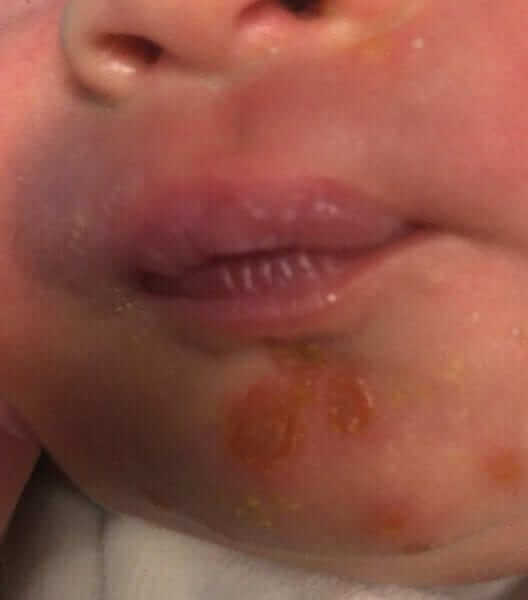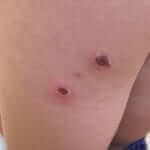
Impetigo
Impetigo is the most common skin infection in children.
First, one should know the two types of impetigo and distinguish between them.
So, read more, learn, and get better treatment for your child.
What are the two types of impetigo?
Non-bullous (non-blister) impetigo – mainly caused by a bacterium called Staphylococcus Aureus (Golden staphylococcus), but also by Group A streptococcus. Yes, the same streptococcus that causes tonsillitis in children although here it infects the skin (read more here on Strep’ throat).
Bullous (blister) impetigo – always caused by specific species of Staphylococcus aureus that produce toxins that cause skin damage and local blistering.
The difference is vital for the understanding that while the first type almost always starts at an area of local trauma to the skin (insect bite, abrasion, Chickenpox, burns etc.). In the second type, the child simply wakes up in the morning with an infected blister and the parents don’t understand how it got there.
How do the bacteria get to the children’s skin?
Since birth, we all have a lot of bacteria on our skin including the two mentioned above. Children carry these two bacteria on their skin in larger quantities.
Transmission of skin bacteria among children is common so if one sunny day your child brushes up against another child at kindergarten that happens to carry a certain type of staphylococcus on the skin, the new bacteria on your child’s skin may cause impetigo.
The area where the carriage of the staphylococcus is highest is around the nostrils of the child. The child picks their nose and transfers the bacteria to other areas of the body.
Streptococcus however, is usually carried only on the skin and the bacterium is normally acquired about 10 days before the appearance of skin lesions.
How do the lesions look like?
Non-bullous impetigo – usually, we will see a yellowish (honey-colored), area on an already existing wound, with local redness around its diameter up to 2 cm wide. Itchy at times.
Bullous impetigo – a blister with a clear content, the roof of which pops soon enough and leaves a round moist and inflamed area sometimes honey-colored. See the second picture.

So, what are the main differences between the two types of impetigo?
Here is a table:
| Non-bullous | bullous | |
|---|---|---|
| Causative bacterium | Usually staphylococcus | Always staphylococcus |
| Prevalence | 70% | 30% |
| Age of children | Small children | Babies and small children |
| Location | Usually in the area of the face and limbs | Face, bottom, limbs |
| Does it occur in an area of local trauma? | Yes | Usually no |
| Treatment | Usually the treatment is local, with or without decolonization | Usually the treatment is systemic, with or without decolonization |
What are the complications of impetigo in children?
Usually there are no systemic complications other than the local infection, which is unpleasant on its own.
Uncommonly, there’s a worsening of the local infection and sometimes formation of a local abscess.
It’s common to see a recurrent infection in the same child or other children in the household.
What is the treatment in each type and what are the principles from which it’s derived?
The decision of whom to treat and how depends on the type, location and number of lesions.
Cases of non-bullous impetigo in a limited area can usually be treated with a local antibiotic cream that is appropriate for said bacteria. In persistent cases, it’s possible to add decolonization to the treatment, explained below.
In cases with significant local infection and extension of the of the infection, appropriate oral antibiotics may be considered, covering the two criminal bacteria causing impetigo.
In bullous impetigo, the approach is a bit more aggressive because even if we treat well locally, still the presence of this specific bacteria on the child’s skin will cause persistence of the infection and in most cases, new lesions will appear in other areas.
Thus, in many cases a 7-day antibiotic treatment will also be given with an appropriate antibiotic. If an oral treatment was initiated, usually there’s no reason to add on local antibiotic cream.
Here too, in persistent cases, in case of recurrence or infection of several children of the same household, decolonization treatment may be considered. Read next.
In addition to all these treatments, itching should be prevented. Itchiness usually appears at the stage when the lesions dry up (and in fact heal), and the child worsens the infection and wounds by itching. A wound that is being fiddled with by the child and opened several times is a wound that may leave a scar. So cut the kid’s nails and consult the doctor about treatment to reduce itchiness.
What about recurrent episodes of impetigo?
An important and debatable topic. Quite a few times I see children suffering from recurrence of impetigo, or a family where several family members are infected in a chain of infections. Therefore, if your child suffers from a recurrent event, I read the next chapter, which discusses exactly these cases of recurrent skin infections.
Is impetigo contagious?
Yes, impetigo is very contagious within the kindergarten or home. Usually, children of similar age or younger contract the infection. The parents don’t contract the infection very often. Transmission is by touch but also using bed linen, towels and shared clothes.
When can a child with impetigo go back to day-care?
It’s possible to go back to day-care about a day after initiation of an appropriate antibiotic treatment in condition that all open or oozing lesions be covered.
To conclude, this is an important topic in pediatric, so I hope this chapter will help get the best treatment for your child skin condition.
For comments and questions, please register
